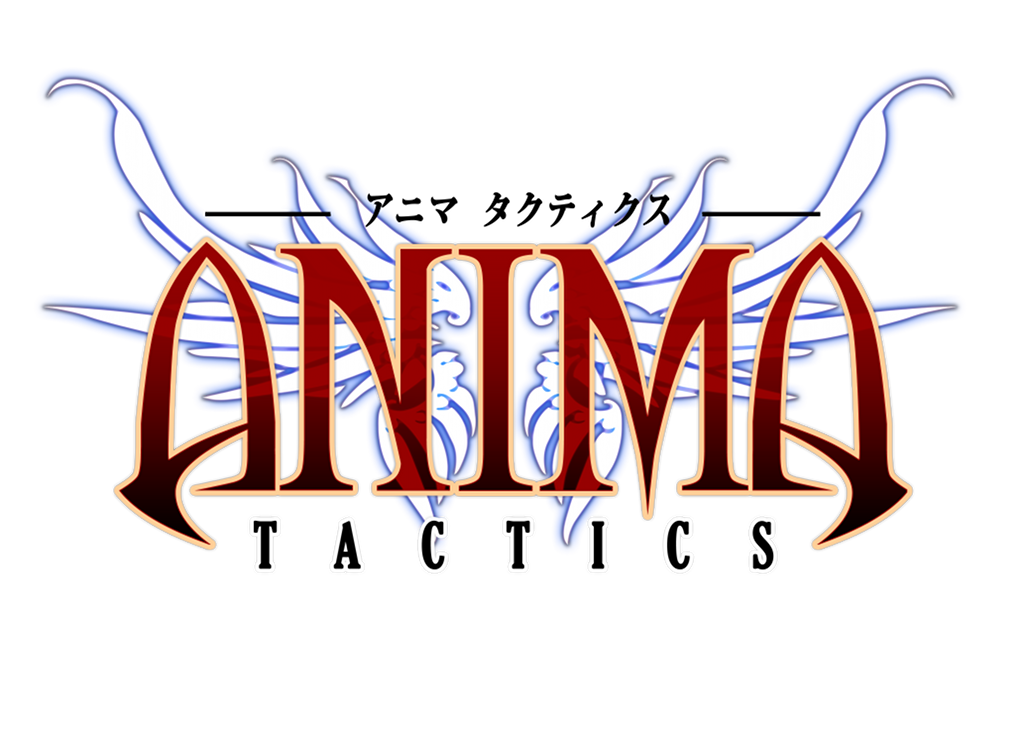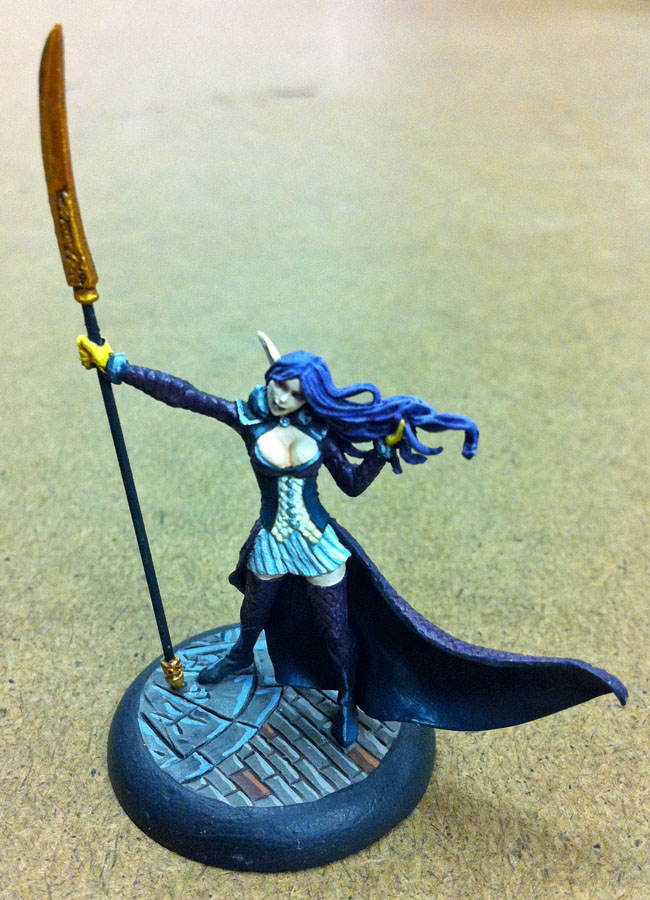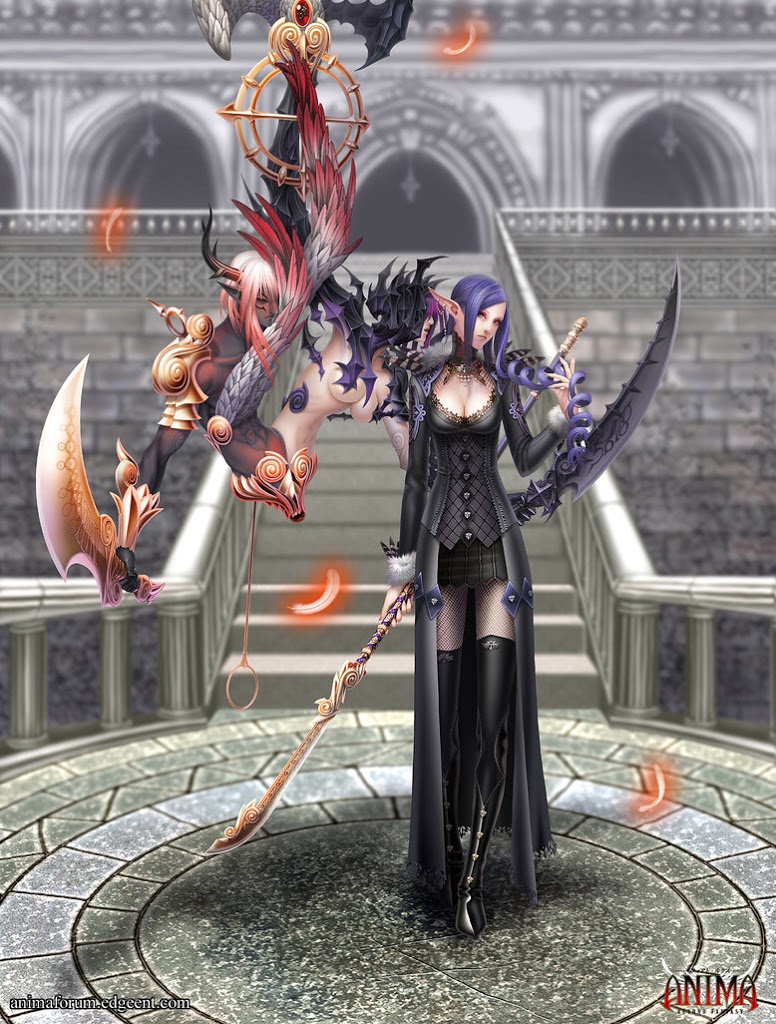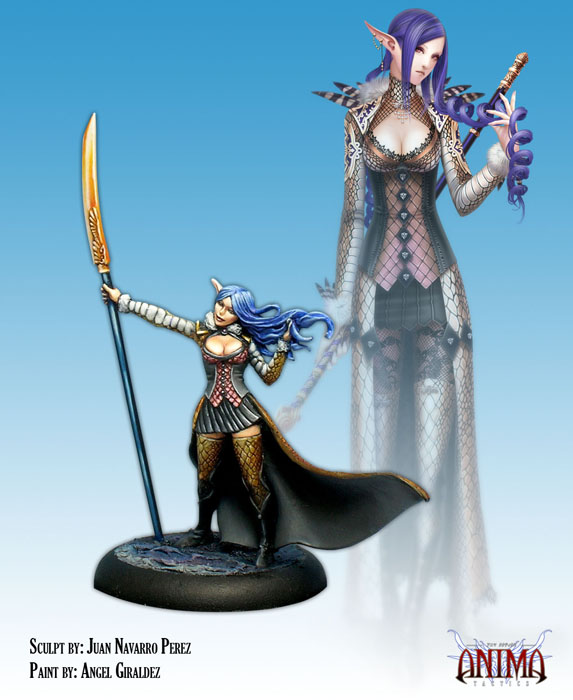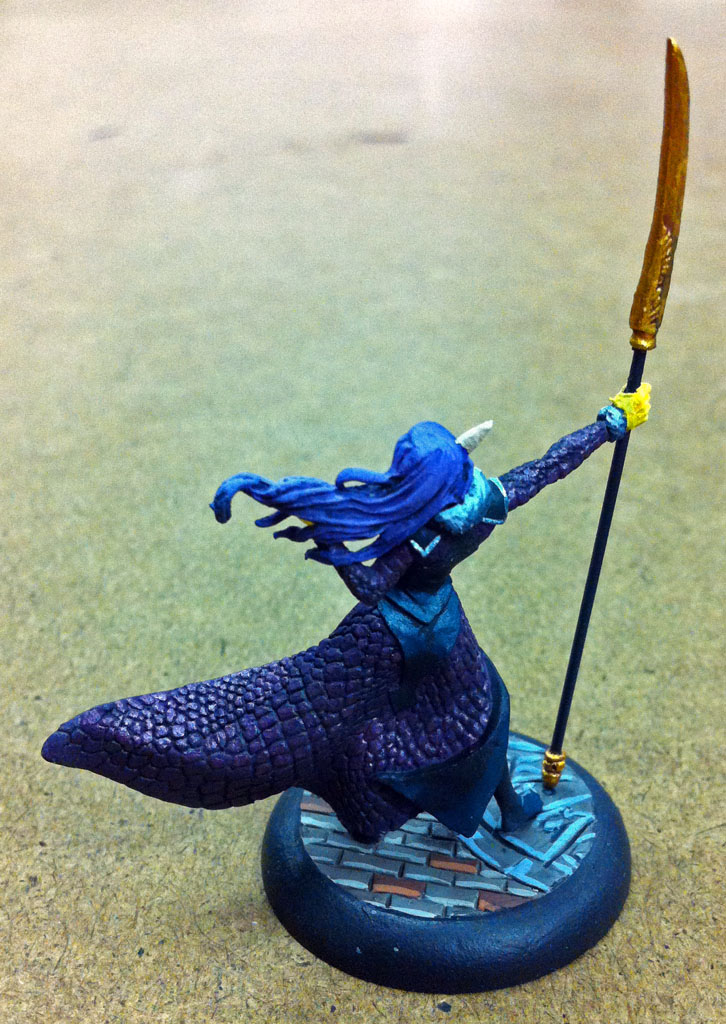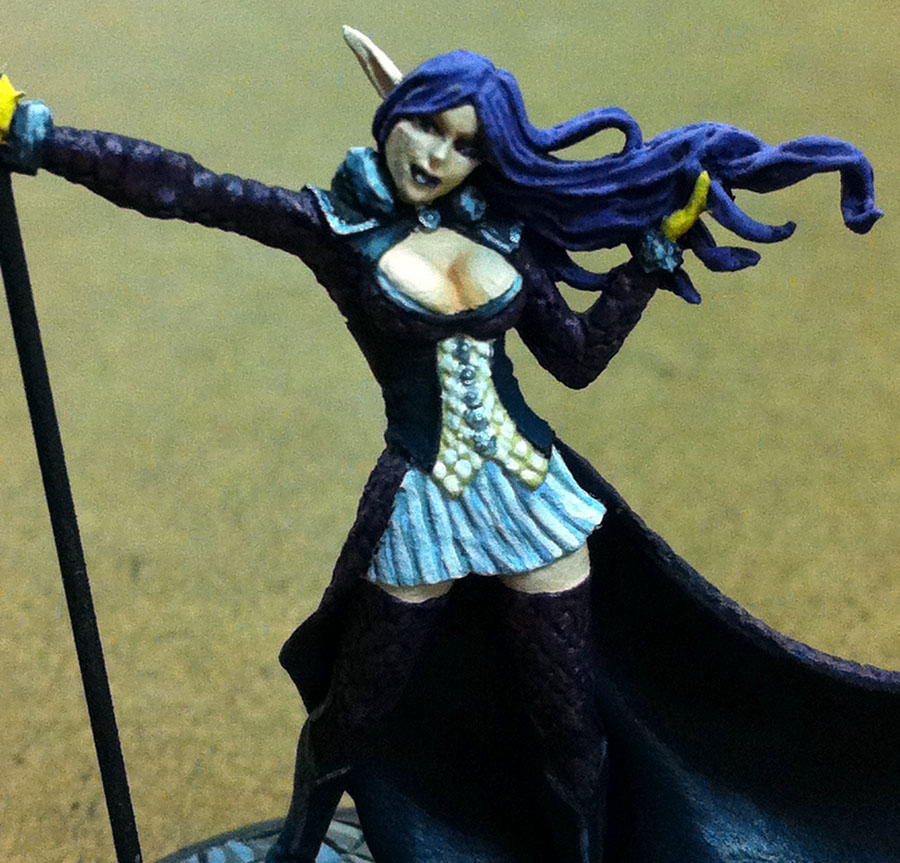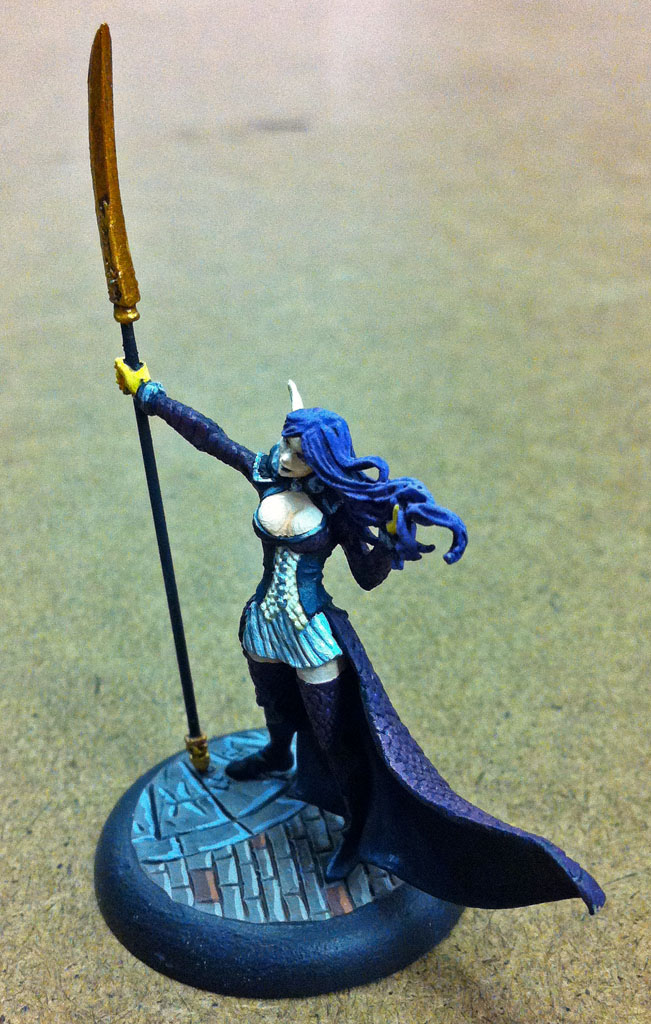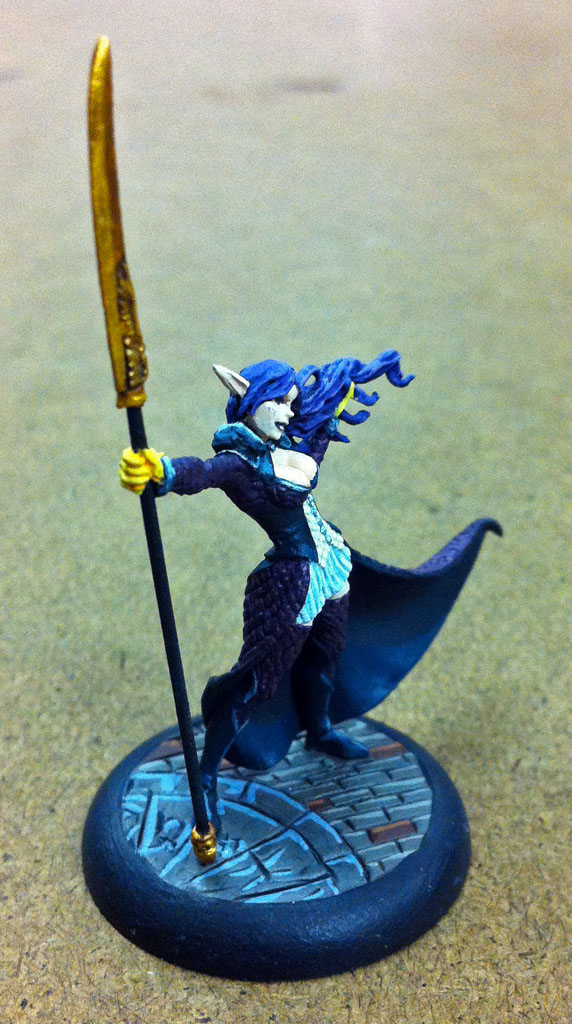Hobby: Valis Ul Del Vilfain (Anima Tactics)

Hey, y’all, Voices here with another painting how-to on another Anima Tactics model, the beautiful sylvain (that’s “elf” in setting-speak) Valis Ul Del Vilfain, Princess of the Arias.
Before we begin, take a quick look at the pictures below; the first is the original by Wen Yu Li, and the second is the production version of Wen’s piece.
Anima’s also one of those games where I’ve gotten into the setting; or, rather, dove in head-first after some hesitation. The organization to which Valis belongs is known as Wissenschaft by a mysterious Prince named Lucanor Giovanni. Within Wissenschaft there are several divisions, the two most notable being the Crows and the Arias. Both of these primarily engage in espionage, with a focus on “black ops.” Valis heads of the Arias. As such–and fitting in with the background of the character and organization–a subdued, stately scheme (not like the shadowy, dangerous tone I used for Aizen) suited the model. And the first step was basing.
Painting the Model
For basing, I decided on the edge of a zodiac wheel set into a brick surface to indicate the wealth that funds Wissenschaft. Much thanks to Spanky Harrison for doing the actual molding of the base based on the pattern I’d drafted; his painting’s damn good, but his sculpting…sometimes, man, wow…
The model was cleaned, and then the tab was very carefully shaved down–the model itself has some small and fragile pieces; and one of them didn’t survive: the spear haft snapped, so I replaced it with brass rod and sculpted a small butt on the end of it.
Then, it was sprayed my usual Krylon matte gray.
I’ve hinted at it before, but I may as well come on out and say it: my home is the city of Austin in central Texas; and I received this model in late July, when the temperature is scheduled to approach or exceed 105 Fahrenheit by midafternoon. Daily. Due to the temperature and (to a lesser degree) humidity, it’s one of the worse environments to use spray paint possible.
Next was actual basecoating. I prefer to color block after spraying and do it with the shade tone so I just have to go up in value. Since I wanted her skin to be pretty pale—elf-like, if you’ll forgive the term—a light tone for the skin worked; I chose Reaper’s Master Series Fair Skin Shadow with a very small dot of Tanned Skin Shadow added to give a slightly deeper tone to the lower inner curves of her jawline under her hair, the very depths of her ears, and (yes…) her decidedly un-elven cleavage. For the clothing, the scaled cloak, jacket arms, and scale-skin boots would get a deep purple (I used a RMS series triad based around subdued purples) significantly less saturated than the purer and more pastel hair (Royal Purples triad). The most horizontally-aligned scales would get a slash of metallic RMS-Sparkling Purple to add a “pearlescent” sheen; though it was very obvious, I liked the effect and left it (in person, it really makes the cloak pop). The non-scale parts would be black with silver lining; the fluffy furry collar would be a gray with obvious brush strokes to give a “cel” look, and the gloves would be yellow to provide a nice contrast with the purple.
Okay, before I continue I’ve got a story: Way back in the day, before there was a Cipher Studios, Privateer Press, or Iron Wind Metals, there was a company that continued to fill the niche Citadel voluntarily gave up when Warhammer and 40K became hits; and that company’s name was Ral Partha. They did miniatures for BattleTech, Dungeons and Dragons, Shadowrun, Hot Lead, and, most notably, generic fantasy miniatures. Inside their box sets, Ral Partha inserted in the early-mid-90s a little cardstock folding pamphlet that was a primer (no pun intended) on painting miniatures, specifically people; it was frustrating for me, because at the time I painted ‘Mecha, not people. But those pamphlets had this great little piece of artwork in them that I can’t find (and couldn’t post even if I could find it!) on how to paint faces in steps and where to apply the various shades. I’ve used that same basic technique ever since. Because–let’s face it (very punny, Voices)–faces are hard!
Faces have all sorts of planes and curves, they catch light in a very overly-complicated fashion (you’d think that the upper eyelids are completely shadowed by the overhanging eyebrows, but in reality they usually get ambient reflected light bounced off the upper cheeks; that reflected light can also partially-blind a person, which is why football players have those black bars of stuff drawn across their cheeks during games…that goop cuts down the reflected-light glare from the players’ cheeks), and generally have a very large amount of fiddly little detail that sculptors repeatedly and valiantly try to capture at 1/120th scale for our amusement and entertainment. Just for fun, take a picture of a face, and see just what light goes where…how reflective–and thus, light-colored—could someone’s eyes be because of all the light bouncing back and forth from the various planes of highly-reflective skin in the eye socket cavity? And don’t forget when thinking about this…the basic structure of the eye is little more than a truncated tube with a mirror (the cornea) at the back; that will give a bit of insight into eye reflectivity.
Her face was progressively—and painstakingly—highlighted bearing in mind the above points, in my usual fashion. Her eyes came next; I brushed her eyes a pearl white, followed by a dot of maroon for her irises. I don’t like to dot the pupil black after that, my brushwork not being fine enough to regularly get the pupil right without covering the majority of the iris; and, further, I feel it detracts some from the tone of the model by “deadening” the eyes. After I finished the eyes–and keeping with my usual method–I colored the upper eyelashes; but instead of using black per usual, I used a near-black purple (specifically, Reaper’s RMS-series Midnight Purple that was used as the shade tone for her hair. Her eyes–but not eyelashes–would get a careful coat of gloss varnish after the model was clearcoated.
It’s popular to do color on the lips of female models to “make them up.” I rarely if ever feel this adds much beyond just beating observers with the “Hey, it’s a woman!” bat (as if the HUGE bustlines didn’t already scream it); and particularly feel that it’s not very “elven” to use makeup. But since Valis is an Ecchi Steampunk-Goth-Lolita-Science elf, I figured “What the hell!” and did a multi-tone purple (starting with RMS Imperial Purple) on her lower lip, lined it with RMS Pale Violet, and dotted RMS Pure White in a corner. Some companies that advise on how to paint this state that painting the upper lip gives a “clownish” appearance to the model, but I also disagree with this assessment: done right (and, honestly, if you’re putting lipstick on your model, you’re being absolutely blatant anyway), it brings out the makeup. Her upper lip got a carefully-applied coat of thinned Midnight Purple; her lips would get a slash of gloss varnish after being clearcoated.
Tactics
As far as playing with Valis goes, she’s fast, with decent attack, damage, and defense values, slightly low armor and incredibly average health. As a summoner, she can bring additional models onto the field; and not only can she have an additional advantage card attached to her–being a member of Wissenschaft and all–but she also afflicts opponents she damages with poison. She has a variety of abilities that inflict weird status effects (Nux, for example, increases the cost of enemy abilities by an additional action point), boost her attacks (Shesha provides a +5 bonus to the attack roll), or give her a ranged combat ability (Arjuna). From everything I’ve learned about how Anima Tactics plays, Shesha and Nux are probably her best abilities.
Additionally, she’s an optional leader; that means that, at a slight increase in points cost, she can be used as a leader for your force. Meister Aria–a specific ability she gets when chosen as a leader–can provide one of a number of bonuses to friendly models; and she gains a further ability to grant her summoned creatures Poisoned attacks…yes, that’s right, an Ignis Fire Demon (or more powerful, if you want) who also inflicts Poison. Fun times.
So that’s my how-to on Anima Tactics’ Valis Ul Del Vilfain. I hope you’ve enjoyed the article, maybe laughed a bit, maybe nodded your head sagely, maybe even shook it in disbelief while saying, “Voices doesn’t know what he’s talkin’ ‘bout…”; and, most importantly, got a little something out of it to help your own painting. As a painter, I don’t tend to stick with one line; I’m a firm believer in Robert De Niro’s line from Ronin: “Well, you know. lt’s a toolbox. You put the tools in for the job.” And with that little bit of misbegotten wisdom, this is All Voices Anonymous, signing off.
Have a good one folks!

